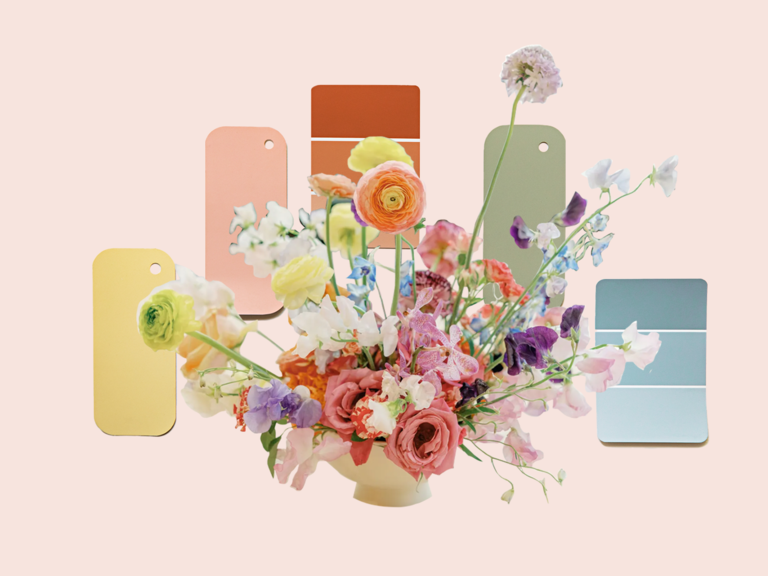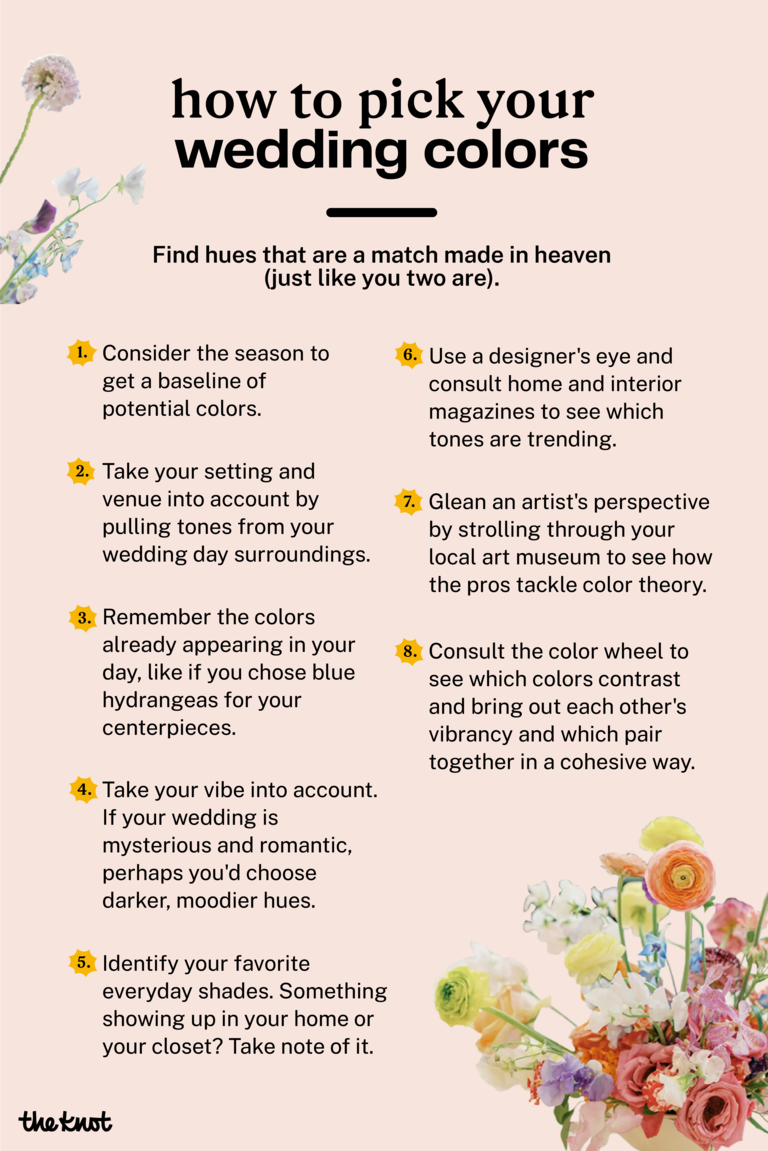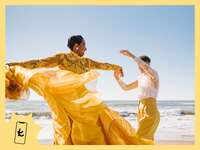How to Pick Wedding Colors With Intention and Care

If you were here right now, we'd be holding your hands and jumping up and down: You're tackling one of the first tasks in phase one of wedding planning, and that's something to be REALLY excited about. The undertaking of how to choose wedding colors is a right of passage. Sifting through different shades to see what resonates is likely the first big style decision you'll make for your celebration, and the resulting hues will act as a helpful springboard for other aesthetic choices, like your wedding vibe and decor. (And if you need some style guidance up front, can we introduce your new best friend: The Knot Style Quiz?) To guide and ground you as you explore different wedding color schemes, we've broken down this decision process into detailed, actionable steps that'll help you identify a wedding color story with depth, nuance and personal resonance. Feel free to follow each one word-for-word or ditch any that don't speak to you; it's your wedding, we're just here to support.
We know it feels like a lot is riding on this decision, but this is such a fun, creative era in your wedding planning process, so don't forget to enjoy it. Think of this generative period as an extended art project where you can do a deep dive into what visual elements capture you and your partner's spirit as a couple. And don't forget to take a deep breath or a chill walk anytime you feel overwhelmed. We're truly over the moon for you—now let's talk colors.
In this story: How many colors should you have? | How to choose your wedding colors (with graphic!) | Should all wedding elements match your colors?
Ready to jump right in? Easy steps for picking your wedding colors: Get Inspired | Narrow Down Your Pool | Pick Your Final Colors | Color Gut Check
How Many Wedding Colors Should You Have?
As a baseline range, you should have anywhere from two to five designated wedding colors. Yes, despite popular belief, you really don't need to choose only two colors for your event. A two-hue color selection can feel limiting and will likely be more challenging to work with in the long run. Think of designating your wedding colors into the following template: two primary or hero colors, one to two secondary colors, one to two accent colors. The primary hero hues will make up the bulk of the wedding, the secondary colors will appear in smaller details, like linens and large areas of your flowers, and the tertiary accent pops might make their way into your tablescapes and decor to add some dimension.
How to Choose Your Wedding Colors
While there's no "right way" to go when it comes to picking wedding colors, we distilled the process down to the following steps to help you cover all of your inspirational and practical bases. But truth be told, the process of how to pick wedding colors could be unique to each couple—it's mostly about intuition and emotion. Here, find a quick pocket guide on how to decide on wedding colors, then keep scrolling for our in-depth, holy-grail method.

1. Create Your Canvas
First and foremost, you'll need a spot to store all of your inspiration. Create a Pinterest board as a landing pad to aggregate images of wedding color combos you're drawn to as you come across them online. You should also download The Knot app to store shots you love from our extensive archive of real weddings (just click the little heart whenever you want to save a photo). If you're also the tangible type, pick up a poster board from your local craft store to serve as a collage canvas where you can house elements like magazine images, fabric swatches, dried flowers and anything else that captures your eye. You can also expand each of these platforms down the line into a full-fledged wedding vision board, where you can keep track of wedding theme ideas and more once you solidify the words to describe your wedding.
2. Get Familiar With Established Wedding Color Combos
Chances are, your final wedding colors will be a more refined and personalized combination, but it's definitely helpful to get familiar with some common wedding colors, classic color pairings and maybe even some current wedding color trends to see what you're into. Green and white, black and white, blush and white, and blue and white are all tried-and-true options (and great blank canvases to build on using secondary colors and accent colors). If you're looking to be directly inspired by a color family (like seasonal colors or pastel colors), you can use those as your North Star instead. We have a wealth of inspirational articles covering wedding colors in detail, so take a look around—we're linking some helpful guides below.
Wedding Color Inspiration by Color: Black and White | Blue | Brown | Green | Magenta | Pink
Wedding Color Inspiration by Season: Fall | Winter | Spring | Summer
Wedding Color Inspiration by Vibe: Beach | Maximalist | Moody | Neutral | Pastel
As you sift through, keep a notebook and pen handy to write down your thoughts and document why you like or dislike a certain pairing or color group. Learning to identify what a color palette lacks in your eyes is just as important as noticing what works for you.
3. See What Strikes You From Real Weddings
The next step (and one of the most fun steps) in choosing wedding colors: looking at a bunch of wedding photos. Use your notes from the previous task to determine what wedding colors you'd like to see more of to deepen your research. First, poke around The Knot Real Weddings section. You can filter by one or more hues to see weddings that match your color criteria, showing each in different shades, seasons and use cases. Maybe this is where you discover an unexpected pairing that really works for you. "Heart" any photo that resonates with you, then it will populate to your The Knot account. You should also add your favorite images to your Pinterest vision board. (Also, if there are any tagged vendors that strike your fancy as you look around, search their name in The Knot Vendor Marketplace to get in touch later on.)
Speaking of Pinterest, expand your search to the platform, searching "[insert color] wedding" to uncover even more visual inspiration. You guessed it: Pin anything that strikes you to your mood board. You should keep your notebook with you during this step too, jotting down thoughts, feelings and surprises. For example, maybe you're getting sold on green, but seeing it paired with pops of purple is something you've never thought of. Track your thoughts and don't worry about organizing any of your images just yet—that will come later.
4. Visit Favorite Spaces
Step away from the screen for a sec: Think of this step as a built-in break. Take a few days or a week to just live your life in the spaces you love most. Walk around and view the world through a lens of color, taking photos of combinations you like that you see in the wild. It could be the hues of the flowers in your favorite local park, the contrasting tones of a cool marquee sign downtown, the sumptuous scheme of your go-to date night restaurant or sexy cocktail bar—inspiration can strike you anywhere. As you continue on your exploratory walk(s), think about the tonality, temperature and saturation you're seeing, considering not just the colors themselves, but how they relate to one another. Add any winning photos to your vision board.
5. Think Like an Artist
Artists are masters of color and color theory, so we'd be remiss to leave them out of the process of how to pick your wedding colors. Explore local art galleries and museums, and look at images of your favorite masterpieces online to find color combination ideas. You will also get a better sense of how light and shadow work with certain colors and the relationship between two or a few hues. Also be mindful of the emotional impact the art has on you, how the colors make you feel when displayed together and how that feeling correlates to the experience you'd like guests to have on your wedding day. (Bonus: Still-life paintings can also provide inspiration for using fresh fruits in your centerpieces—one of the top wedding trends as of late.)
6. Use an Interior Designer's Eye
There's so much overlap between stylish celebrations and interior design. We can thank this field for many cutting-edge developments and trends in the wedding space, like the pop of red theory and the constant innovation that comes with the Pantone color of the year. That said, you should definitely consult interior design publications and inspiration photos to uncover some out-of-the-box combos as you create a color palette for your wedding. Search online interior design mags and Pinterest for "[insert color] interior" and poach any images you like for your inspo board. You can also search for certain interior design styles that are akin to the types of colors you're drawn to thus far, i.e. Japandi design for earthy neutrals, Danish pastel design for soft and whimsical tones, Memphis design for bold brights and so on.
7. Get Inspired at Home
Get that notebook out again. Your home can be just as inspirational as a magazine-worthy wedding photo in regard to what colors you gravitate toward. Take a lap or two around your house and write down what colors you see the most along with any thoughts. Is your home mostly beige? How does that make you feel? What colors aren't you seeing at all? What hues work especially well with the dominant shade present? After a lap with the notebook, grab a tote bag and gather any clothing items, textiles, books with cool covers or decor pieces that draw you in. Assemble them together in the same spot when you're done and evaluate your findings: Do you like different shades of one color? Are there lots of brights and maximalist hues? Are certain natural textures like wood, marble or wicker that naturally lend themselves to a certain color prevalent? Write down your notes.



8. Cull Your Inspiration Pool
At this point, you should have all of your images on your Pinterest board or your physical mood board (if you went that route). Now, it's time to trim down your vast pool of inspiration—think of it like carving a sculpture from a block of marble. We recommend using two "mental filters," so to speak, to initially refine your pool: season and setting. Considering your wedding season (if you have one) as a way to narrow down your potential color potions instead of a starting point will ensure the resulting hues don't feel too thematic or overdone. That's not to say that you can only use certain colors during certain seasons; the trick is how you style them. If pink is your ideal wedding color, a soft rosy version is perfect for spring, while bright coral is a summer wedding staple. For fall, a purple-pink fuchsia pairs well with other jewel tones, while muted mauve and silver are a pretty wintry combo. Adding accent colors can also help lighten or darken your color curation for different seasons. Same goes for setting—if you know you'll be having an outdoor wedding in New England or, better yet, you have an actual venue or two in mind, you can remove any images/color options that don't suit your space or locale. Sift through every image you have added to your board and remove any that don't work, or make a note of how to style them in a way that makes sense. Store them in a folder on your computer or on a separate Pinterest "color rejects" board, just in case.
9. Fine-Tune By Style and Mood
By now, you'll likely have a budding sense of your overall wedding aesthetic or vibe. To help round out that vision, take our quiz that covers what your wedding colors should be, how your wedding style is defined and more. Think about the style and atmosphere you want your wedding reception to have, whether it's relaxed, glamorous or something in between, and imagine colors that put you in that mindset. Then, give your photos another pass and remove any hues that don't work with your wedding's feel and the notes you've been collecting thus far. Be sure to be mindful of tone as you go, since nearly any color can work in your wedding color combo if the shade is right. Example: A bright purple might not work for a romantic, moody affair, but a rich eggplant would. Ensure all of the hues you're left with are relatively cohesive undertone wise (warm or cool). Do note that you can fine-tune everything as you go, since colors look different IRL. (Also, for any superstitious soonlyweds, you can identify any good luck wedding colors and get rid of any bad luck wedding colors from the mix here as well.)
10. Organize Your Inspiration
You should now have a refined collection of wedding color images—yay! Now it's time to grab a snack, a hot tea and settle in to organize your final group of color inspo shots. Create different sections within your board, either categorized by the dominant color showing up in each photo (pink, purple, green), the main type of colors (neutrals, pastels, high contrast, brights) or the overall energy and use of the colors (earthy moody, monochrome, retro). Use options from one, two or all three categories—whatever feels right and helps you identify trends in what you like.
11. Evaluate Your Findings
The time has come: Take a step back and evaluate how your final vision board looks. Is there a dominant hue or color family? What category has the most images? Is one color presenting in one or multiple shades? (Do you like forest, celery and sage green? Or just emerald?) Does anything feel out of place?
12. Pick the Primary Colors
After you've given your vision board a long look, it's time to choose your first hues. Select one or two primary colors to make up the bulk of your palette. You can go by the color that appears the most and in significant ways in your inspiration photos, or a favorite you've identified. If you're drawing a blank, choose the hue or hues that will give a great grounding base for your secondary and accent colors to provide pops and fill in the blanks. For example, a powder blue could keep a rich navy from overwhelming the room and dashes of ivory will bring in some breathing room.
13. Choose Secondary Hues
As you consider what shade or shades should make up the bulk of your wedding, it's time to select a secondary color. You can use this interior design color formula to gather your thoughts on how to choose your wedding colors: If your hero color or colors make up 60% of the space, your secondary color or colors should cover 30% (with the remaining 10% set aside for poppy accents). A secondary tone can expand or deepen your hero color (like how a forest green would enrich a sage hero color) or bridge the gap between your two hero hues (orange would relate a rich red and golden yellow). Look at the photos on your board that show off your hero color and see what the next-most-present tones are to get inspired.
14. Consult the Color Wheel for Accent Colors
Okay, we know this old-school tool may not have made an appearance in your life since middle school art class, but thinking of the classic color wheel as a wedding color chart instead can help you hash out your final few shades. Finish off your wedding color selection by choosing an accent color or two to tie everything together. Use the color wheel to see how different colors interplay with one another and determine how you'd like your accent color(s) to work, whether you'd like them to add a jolt of brightness or some cohesive depth. If it's the former, perhaps choose a color on the opposite side of the wheel from your hero colors for your accent (red if you have lots of green). If the latter, then you might select an accent hue that appears next to one of your hero or secondary colors on the wheel (if you have blue and violet in your selection, you might select a blue-violet color or turquoise).
15. Fact Check How It Might Look IRL and Admire Your Work
Woo! You've constructed your wedding color combination—and that deserves a glass of bubbly or a sumptuous nap (or both). To gut check your wedding colors, you can do a quick Pinterest search to see if there are any examples of how they come together. And remember, these colors aren't the be-all and end-all. While your wedding colors will inform a lot of your other decisions, like your flowers and your decor, you should use them as a guideline instead of a rule. You should also feel empowered to switch out your hues as you go. Not every part of your wedding has to match perfectly—and in fact, a tonal color curation often looks more sophisticated than a matchy-matchy one, so don't stress about getting every detail color-coded just right.
Do Wedding Elements Have to Match Your Colors?
There are no set rules for wedding colors, though, there are some helpful best practices to reference. You should aim to have one to two primary or hero hues and one accent color at the least, unless you decide you're going for a monochromatic look as you discover how to choose wedding theme colors. Even so, you can still play with tonality and texture. As aforementioned, a full slate of wedding colors will likely contain five different hues: two primary, one to two secondary and one to two accent colors.
If you're wondering: "Do wedding invitations have to match your wedding colors?" Or: "Does your bouquet have to match your wedding colors?" The answer for both is a resounding "kind of." A few tones from your color selection should appear on each of these wedding elements (this is where those accent pops come in). Your stationery and flowers should feel in the world of your wedding, but don't need to be an exact match to your full slate of chosen colors. Prewedding events like a bridal shower, rehearsal dinner, welcome party or engagement party can have their own colors as well. And while we're answering questions, if you're asking: "Do I need to pick colors for my wedding?" The answer is yes, it's a smart idea.
For example, you might have a venue illustration on your wedding invites or save-the-dates, and the venue's exterior is not one of your wedding colors. You might opt to include a watercolor ribbon border painted in one of your wedding hues, and perhaps include another in the font, giving a hint at what's to come, but leaving some surprises as far as the full color spectrum goes. You should keep the same color mindset as you create your wedding website. Likewise, your bouquet and florals could include lots of lush greenery to the point where it's a noticeable presence, but green might not be an official wedding color for you. This will simply add natural depth and dimension to the overall look. Overall, the rule of thumb that's especially applicable for decor accents, flowers and similar wedding elements is "if you like it, it will look good." Keeping this in mind will result in a layered, thoughtful event that genuinely reflects your love story.

























